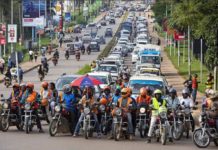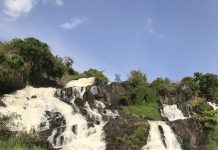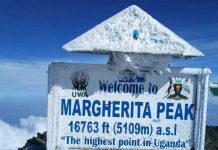A day to remember is when we visited the Semliki national park which is famous and the most birding destination. It was a great morning when we departed from Murchison falls to Semliki national park via Masindi, Hoima and Fort portal to Bundibugyo. It was an adventurous trip to the land and home of birds Semliki national park which sprawls across the Semliki valley on the remote western side of mountain Rwenzori. It comprises of the true lowland rainforest in east Africa hosting 144 recorded bird species and 53 mammals. It is a less visited national park but mere reaching there, you only see wonders. It was a long journey by bus and hour break in the journey was at kagadi town for lunch were we enjoyed the local cuisine served, did some shopping to take us through the trip of Semliki national park. Fun filled the bus because students danced to the music played by cassette this kept us active throughout the trip.
We descended reaching in the evening hours straight to Semliki safari lodge. We met with the park guide who gave us a briefing about the park where he talked many things such as the history, the park activities and the uniqueness of the park. He narrated to us the location were by its located in Bwamba country in Ntandi town in western part of Bundibugyo. It’s the newest park which was gazatted in 1993, richest area of flora and fauna bordering Semliki and River Lamia which are watering areas for animals. The park has two hotsprings, a male called Bitende and a female called Nyasimbi. Flooding occurs during the wet seasons at the park.
The park is surrounded by a distinct ecosystem with several climate and ecological zone with a diversity of plants and animal species found in the Congo basin reaching the limit of eastern range in Semliki national park, Semliki national park is blessed with attractions such as the great Huri forest of Congo, Semliki Valley, thatched huts, Central African wildlife species, Batwa pygmy community, hot spring, bird species among others. We rested for a few hours while preparing for an evening game drive. This activity was done in the Semliki game reserve and here we encountered different wildlife species such as the big five mammals, like the elephants, lions, warthogs, water bucks, giant forest hogs, African buffalo, duikers, civets, bush babies, pygmy baby squirrels hyenas among others. We went back to the lodge and retired for a night.
Early the following morning, we woke up with the morning breeze had breakfast at the lodge and headed for bird watching at the toro Semliki wildlife reserve. We saw a few wildlife species since it’s not the best destination for wildlife viewing but it’s a paradise for bird watching. More than 460 birds are recorded but we got a chance to see different kinds such as the lyre –tailed honey guide ,216 true forest birds which are the rare forest ground thrush and sassi’s olive greenbul. We were not able to spot the shoe bill stork since it needed us to do a boat canoeing on Lake Albert in search for it which we didn’t do. The air at the park smells fresh and it takes stress and calms one’s mind.
While at the park, many tourists flock to Semliki to see the Sempaya hot springs. Though it is believed to be the rarely visited park, we went to the park headquarters, met with our guide to take us through the next activity. We descended through the forest following the forest trails passing through narrow dirt road network were we encountered forest primates like the vervet monkey, grey cheeked mangabey, black and white colubus and birds swinging from branches to branches. We reached the boiling hot springs which were at 100 degrees Celsius hot while the hot water bubbles spurt upwards producing a cloud of steam penetrating through the rocks after being heated beneath the grounds. We had carried with us eggs which we put in the boiling geyser and cooked for 30 minutes and the surrounding streams were hot and the temperatures so high around the hotsprings eggs and food boiling at the hot spring is carried out on Nyasimbi the female hot spring. At the end of the year people from far and nearby villages to come for cultural ceremonies mostly the Bwamba and pray to the hot spring gods requesting for healing, deliverance and blessings upon them. The locals come back with gifts to offer to the gods after their prayers are answered. It felt good and conducive as piles of sweat dropped off our bodies due to the hot temperatures.
We continued to the male hot spring which was a far distance from the female. We passed through forests following a wooden bridge but this was a scary moment. People were terrified to pass on the wooden bridge since it looked kind old. But after being persuaded by the park guide the situation came back to normal as we took the trail to Bitende. The male hot spring was circular in form like a pond structure hotter than the female one. We were not allowed to get so close because the temperatures were far much higher than that of Nyasimbi. It was so adventurous and entertaining as we could see the water bubbles spurting out of the circular hot spring. It is surrounded by green vegetation which had water underneath.
“The hot spring has its folklore deriving its name from a Swahili Sehemu Bwamba meaning difficult life. Wild life flocks to the hot springs but can hardly survive for so long because the temperatures are extremely hot. The women were walking in the afternoon and met a weird man sharpening his spear with a dog. The women ran in fear and called their husbands who came and took the man to the village, gave him a wife called Nyasimbi and life moved on but one day as the man went hunting, he never showed up. When news reached in the ears of the villagers, they went looking for him seeing discovering the spear. News reached to the wife who also ran off aimlessly into the forest leaving behind her clothes at the female hot spring. The Sempaya derives its twin names from the couple Bitende and Nyasimbi and the Bwamba local people come to the hot springs to sake guidance from their ancestors” said the park guide
Semliki national park is referred to as the difficult life since it was very difficult to construct the Bundibugyo road due to the remoteness and the rocks from mountain Rwenzori. As we were traveling back from the male hot spring the trail gave a clear view of the lowland rainforest. It was a long day experience of natural exposure to nature. Semliki national park offers a chance of different park activities though some activities are not indicated on the safari itinerary unless you are a birder but the vast beauty presents a diversity of central African plants, flower, trees, mammals, jungle, reserves, Semliki River among others makes it a better place to be included in your safari.
The following day we went for a guided nature walk hiking through the nature trail which exposed us to wildlife species like hippopotamus, crocodiles, birds, monkey’s. We took packed lunch and a bottle of water which we took in the afternoon hours we encountered bird species and primate and elephants along the Semliki River. Before reaching the river we could hear thunderous roar of water flowing from a far distance. We equipped ourselves with hiking gears such as jungle boots, long sleeved shirt and light rain jacket since the forests are wet with dew, among others. In the evening we headed for a cultural encounter meeting up with the Batwa pygmies and the Bambuti. We came two know that these are two different groups of the locals having different ways and culture though they have lived in the forest for quite some good years like thousands. The number of the Bambuti is much smaller than the Batwa people. These groups of people were evicted from the forests though the Bambuti has limited hunting and gathering rights. Back in the days the Bambuti were un friendly to the visitors but currently they have a Bambuti guide. They are believed to be growing legally growing Marijuana which they smoke. We grinded wheat at the grinding stone which was amazing. We also tasted some of their local cuisine and entertained their cultural dances and folktales.
We missed out with chimpanzee tracking though the guide informed us that “trekking is done since they are presently habituated by Indiana University and here you carry with you protective gears like boots, nettles, snacks like dried nuts, a bottle of water, and it’s done in the morning hours from 2- 6 hours experience with a one hour interaction, taking photos, videos, and here you encounter other primates such as the baboons, vervet monkeys, grey cheeked mangabey among others.
After all the mentioned activities done at the Semliki national park, we packed and travelled back to Kampala. The safari was full of memorable experiences of the Semliki attractions and our investment didn’t go to waste.





